Vincent Christlein
Pattern Recognition Lab, FAU Erlangen-Nürnberg
ICFHR 2020 Competition on Image Retrieval for Historical Handwritten Fragments
Oct 20, 2020

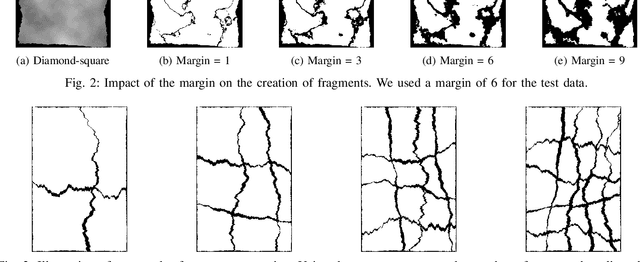
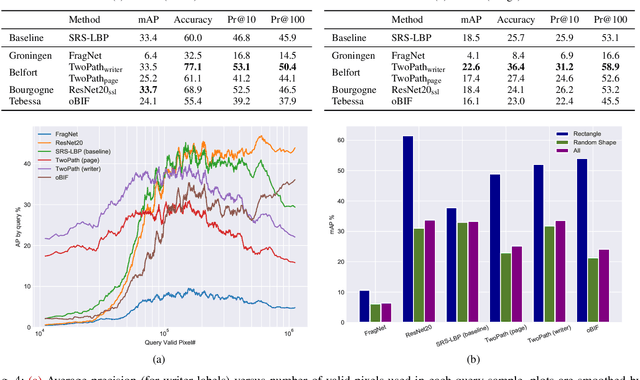
Abstract:This competition succeeds upon a line of competitions for writer and style analysis of historical document images. In particular, we investigate the performance of large-scale retrieval of historical document fragments in terms of style and writer identification. The analysis of historic fragments is a difficult challenge commonly solved by trained humanists. In comparison to previous competitions, we make the results more meaningful by addressing the issue of sample granularity and moving from writer to page fragment retrieval. The two approaches, style and author identification, provide information on what kind of information each method makes better use of and indirectly contribute to the interpretability of the participating method. Therefore, we created a large dataset consisting of more than 120 000 fragments. Although the most teams submitted methods based on convolutional neural networks, the winning entry achieves an mAP below 40%.
Deep Learning-based Pipeline for Module Power Prediction from EL Measurements
Sep 30, 2020

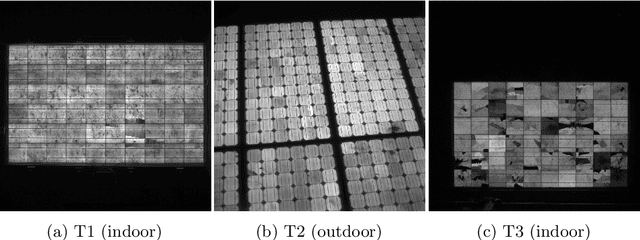

Abstract:Automated inspection plays an important role in monitoring large-scale photovoltaic power plants. Commonly, electroluminescense measurements are used to identify various types of defects on solar modules but have not been used to determine the power of a module. However, knowledge of the power at maximum power point is important as well, since drops in the power of a single module can affect the performance of an entire string. By now, this is commonly determined by measurements that require to discontact or even dismount the module, rendering a regular inspection of individual modules infeasible. In this work, we bridge the gap between electroluminescense measurements and the power determination of a module. We compile a large dataset of 719 electroluminescense measurementsof modules at various stages of degradation, especially cell cracks and fractures, and the corresponding power at maximum power point. Here,we focus on inactive regions and cracks as the predominant type of defect. We set up a baseline regression model to predict the power from electroluminescense measurements with a mean absolute error of 9.0+/-3.7W (4.0+/-8.4%). Then, we show that deep-learning can be used to train a model that performs significantly better (7.3+/-2.7W or 3.2+/-6.5%). With this work, we aim to open a new research topic. Therefore, we publicly release the dataset, the code and trained models to empower other researchers to compare against our results. Finally, we present a thorough evaluation of certain boundary conditions like the dataset size and an automated preprocessing pipeline for on-site measurements showing multiple modules at once.
Understanding Compositional Structures in Art Historical Images using Pose and Gaze Priors
Sep 08, 2020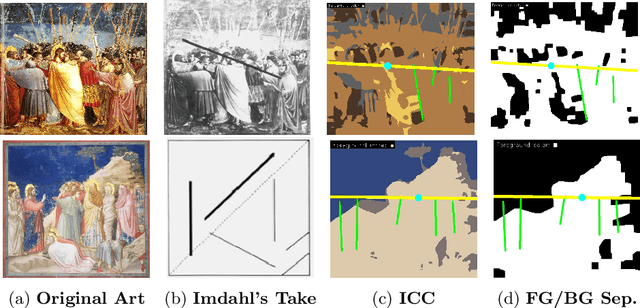

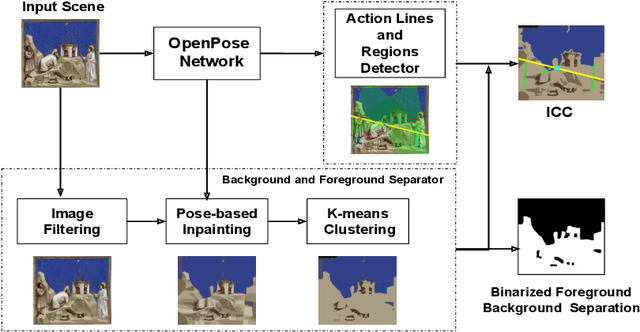

Abstract:Image compositions as a tool for analysis of artworks is of extreme significance for art historians. These compositions are useful in analyzing the interactions in an image to study artists and their artworks. Max Imdahl in his work called Ikonik, along with other prominent art historians of the 20th century, underlined the aesthetic and semantic importance of the structural composition of an image. Understanding underlying compositional structures within images is challenging and a time consuming task. Generating these structures automatically using computer vision techniques (1) can help art historians towards their sophisticated analysis by saving lot of time; providing an overview and access to huge image repositories and (2) also provide an important step towards an understanding of man made imagery by machines. In this work, we attempt to automate this process using the existing state of the art machine learning techniques, without involving any form of training. Our approach, inspired by Max Imdahl's pioneering work, focuses on two central themes of image composition: (a) detection of action regions and action lines of the artwork; and (b) pose-based segmentation of foreground and background. Currently, our approach works for artworks comprising of protagonists (persons) in an image. In order to validate our approach qualitatively and quantitatively, we conduct a user study involving experts and non-experts. The outcome of the study highly correlates with our approach and also demonstrates its domain-agnostic capability. We have open-sourced the code at https://github.com/image-compostion-canvas-group/image-compostion-canvas.
The Notary in the Haystack -- Countering Class Imbalance in Document Processing with CNNs
Jul 15, 2020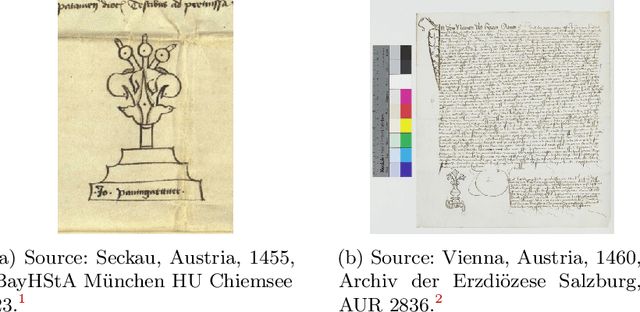
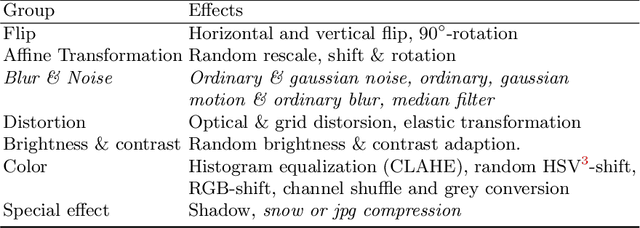
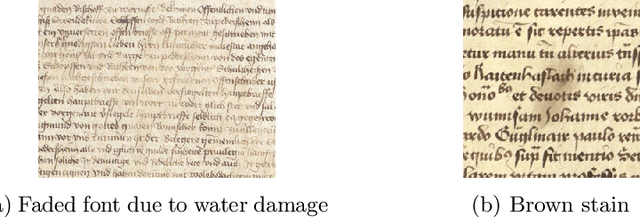
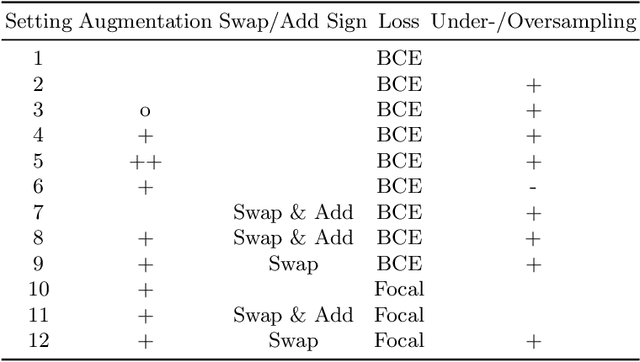
Abstract:Notarial instruments are a category of documents. A notarial instrument can be distinguished from other documents by its notary sign, a prominent symbol in the certificate, which also allows to identify the document's issuer. Naturally, notarial instruments are underrepresented in regard to other documents. This makes a classification difficult because class imbalance in training data worsens the performance of Convolutional Neural Networks. In this work, we evaluate different countermeasures for this problem. They are applied to a binary classification and a segmentation task on a collection of medieval documents. In classification, notarial instruments are distinguished from other documents, while the notary sign is separated from the certificate in the segmentation task. We evaluate different techniques, such as data augmentation, under- and oversampling, as well as regularizing with focal loss. The combination of random minority oversampling and data augmentation leads to the best performance. In segmentation, we evaluate three loss-functions and their combinations, where only class-weighted dice loss was able to segment the notary sign sufficiently.
Proof of Concept: Automatic Type Recognition
Jul 15, 2020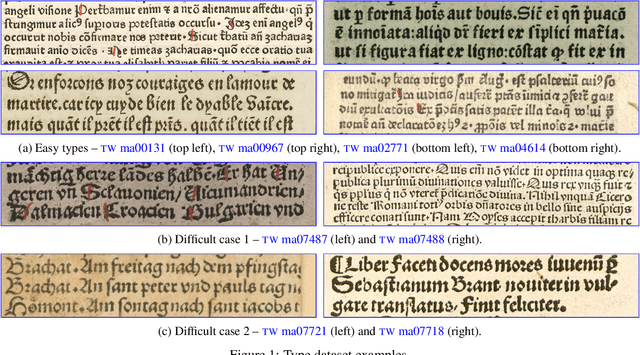


Abstract:The type used to print an early modern book can give scholars valuable information about the time and place of its production as well as the printer responsible. Currently type recognition is done manually using the shapes of `M' or `Qu' and the size of a type to look it up in a large reference work. This is reliable, but slow and requires specialized skills. We investigate the performance of type classification and type retrieval using a newly created dataset consisting of easy and difficult types used in early printed books. For type classification, we rely on a deep Convolutional Neural Network (CNN) originally used for font-group classification while we use a common writer identification method for the retrieval case. We show that in both scenarios, easy types can be classified/retrieved with a high accuracy while difficult cases are indeed difficult.
Re-ranking for Writer Identification and Writer Retrieval
Jul 14, 2020
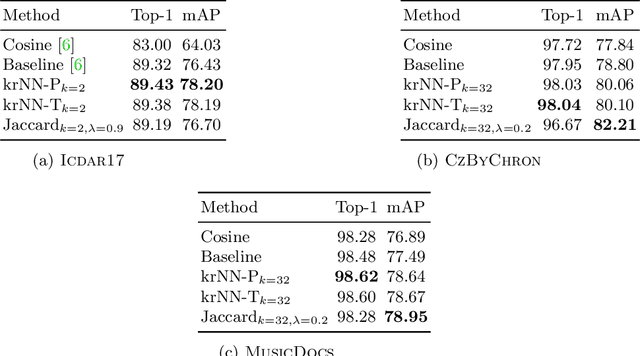
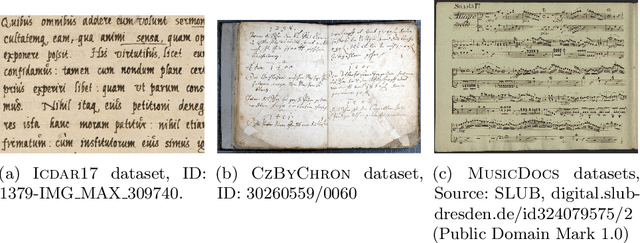
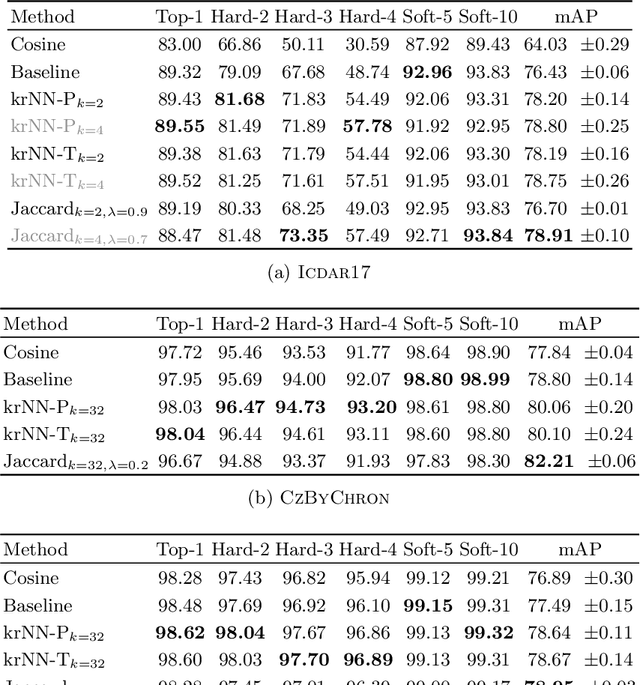
Abstract:Automatic writer identification is a common problem in document analysis. State-of-the-art methods typically focus on the feature extraction step with traditional or deep-learning-based techniques. In retrieval problems, re-ranking is a commonly used technique to improve the results. Re-ranking refines an initial ranking result by using the knowledge contained in the ranked result, e. g., by exploiting nearest neighbor relations. To the best of our knowledge, re-ranking has not been used for writer identification/retrieval. A possible reason might be that publicly available benchmark datasets contain only few samples per writer which makes a re-ranking less promising. We show that a re-ranking step based on k-reciprocal nearest neighbor relationships is advantageous for writer identification, even if only a few samples per writer are available. We use these reciprocal relationships in two ways: encode them into new vectors, as originally proposed, or integrate them in terms of query-expansion. We show that both techniques outperform the baseline results in terms of mAP on three writer identification datasets.
Recognizing Characters in Art History Using Deep Learning
Apr 01, 2020
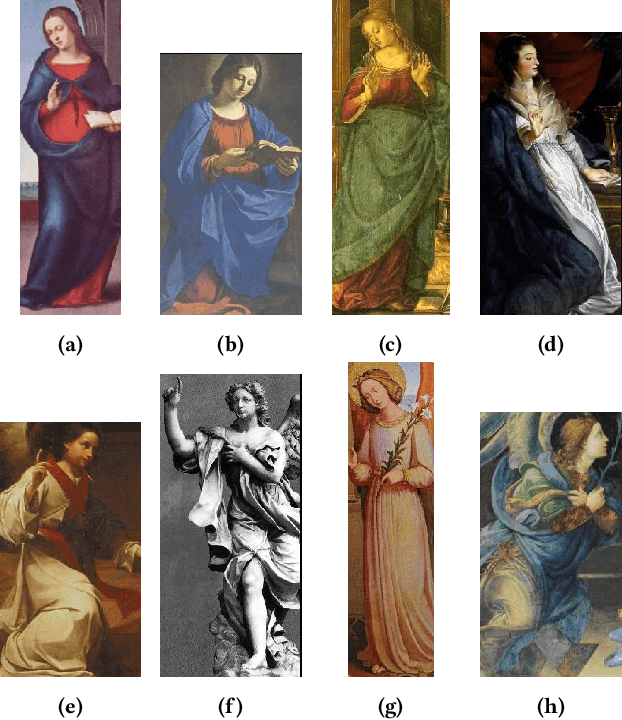

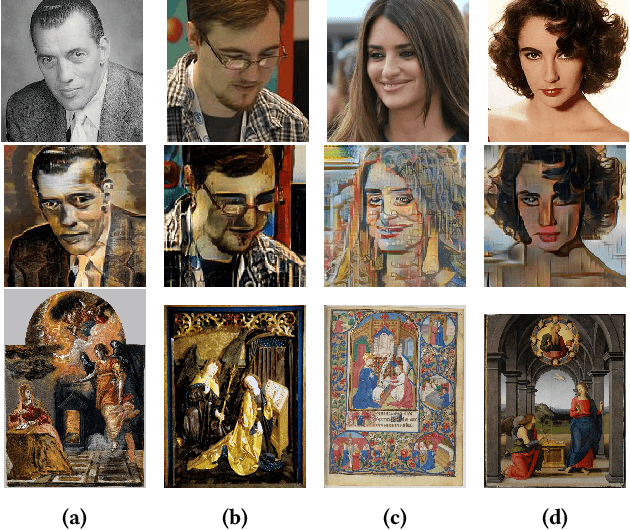
Abstract:In the field of Art History, images of artworks and their contexts are core to understanding the underlying semantic information. However, the highly complex and sophisticated representation of these artworks makes it difficult, even for the experts, to analyze the scene. From the computer vision perspective, the task of analyzing such artworks can be divided into sub-problems by taking a bottom-up approach. In this paper, we focus on the problem of recognizing the characters in Art History. From the iconography of $Annunciation$ $of$ $the$ $Lord$ (Figure 1), we consider the representation of the main protagonists, $Mary$ and $Gabriel$, across different artworks and styles. We investigate and present the findings of training a character classifier on features extracted from their face images. The limitations of this method, and the inherent ambiguity in the representation of $Gabriel$, motivated us to consider their bodies (a bigger context) to analyze in order to recognize the characters. Convolutional Neural Networks (CNN) trained on the bodies of $Mary$ and $Gabriel$ are able to learn person related features and ultimately improve the performance of character recognition. We introduce a new technique that generates more data with similar styles, effectively creating data in the similar domain. We present experiments and analysis on three different models and show that the model trained on domain related data gives the best performance for recognizing character. Additionally, we analyze the localized image regions for the network predictions. Code is open-sourced and available at https://github.com/prathmeshrmadhu/recognize_characters_art_history and the link to the published peer-reviewed article is https://dl.acm.org/citation.cfm?id=3357242.
Spatio-Temporal Handwriting Imitation
Mar 24, 2020

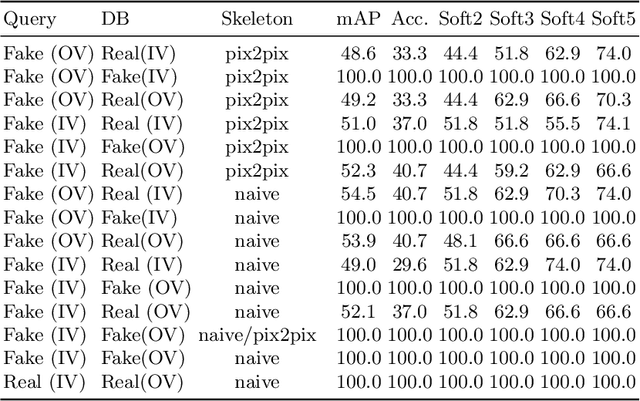

Abstract:Most people think that their handwriting is unique and cannot be imitated by machines, especially not using completely new content. Current cursive handwriting synthesis is visually limited or needs user interaction. We show that subdividing the process into smaller subtasks makes it possible to imitate someone's handwriting with a high chance to be visually indistinguishable for humans. Therefore, a given handwritten sample will be used as the target style. This sample is transferred to an online sequence. Then, a method for online handwriting synthesis is used to produce a new realistic-looking text primed with the online input sequence. This new text is then rendered and style-adapted to the input pen. We show the effectiveness of the pipeline by generating in- and out-of-vocabulary handwritten samples that are validated in a comprehensive user study. Additionally, we show that also a typical writer identification system can partially be fooled by the created fake handwritings.
Weakly Supervised Segmentation of Cracks on Solar Cells using Normalized Lp Norm
Jan 30, 2020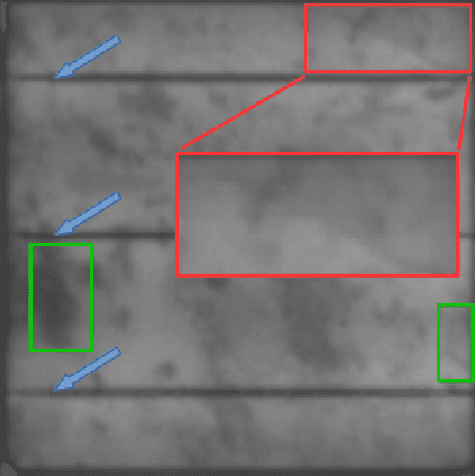

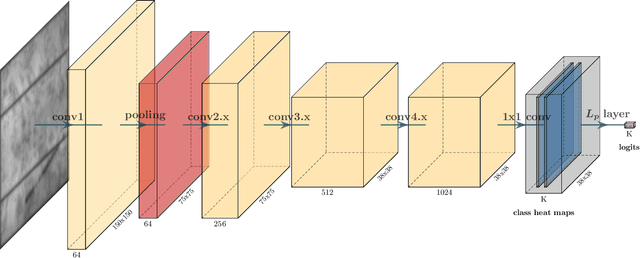

Abstract:Photovoltaic is one of the most important renewable energy sources for dealing with world-wide steadily increasing energy consumption. This raises the demand for fast and scalable automatic quality management during production and operation. However, the detection and segmentation of cracks on electroluminescence (EL) images of mono- or polycrystalline solar modules is a challenging task. In this work, we propose a weakly supervised learning strategy that only uses image-level annotations to obtain a method that is capable of segmenting cracks on EL images of solar cells. We use a modified ResNet-50 to derive a segmentation from network activation maps. We use defect classification as a surrogate task to train the network. To this end, we apply normalized Lp normalization to aggregate the activation maps into single scores for classification. In addition, we provide a study how different parameterizations of the normalized Lp layer affect the segmentation performance. This approach shows promising results for the given task. However, we think that the method has the potential to solve other weakly supervised segmentation problems as well.
ICDAR 2019 Competition on Image Retrieval for Historical Handwritten Documents
Dec 08, 2019
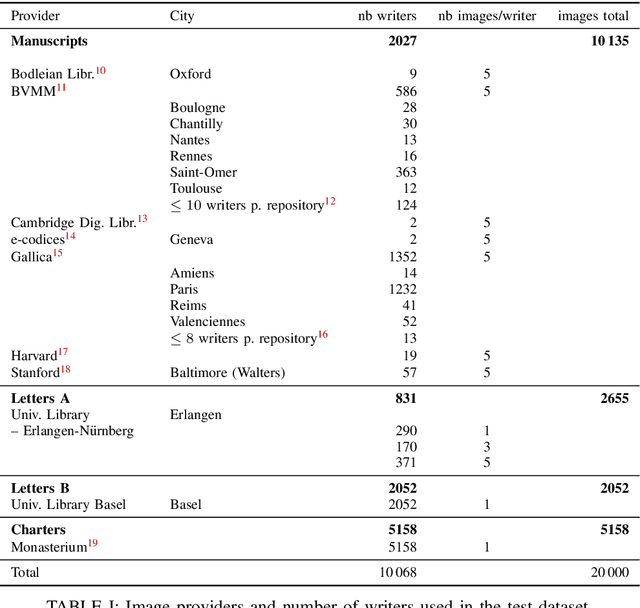
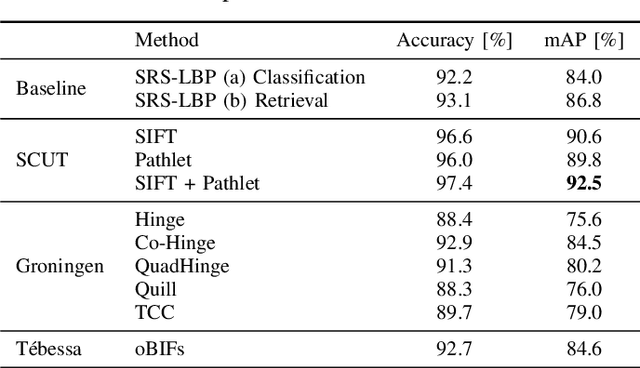
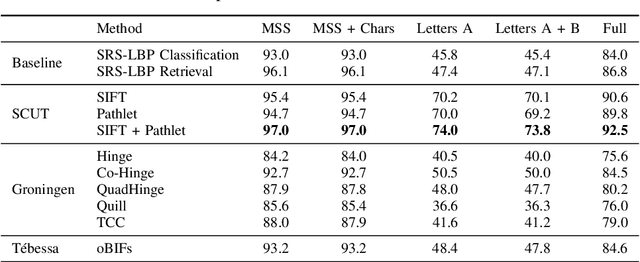
Abstract:This competition investigates the performance of large-scale retrieval of historical document images based on writing style. Based on large image data sets provided by cultural heritage institutions and digital libraries, providing a total of 20 000 document images representing about 10 000 writers, divided in three types: writers of (i) manuscript books, (ii) letters, (iii) charters and legal documents. We focus on the task of automatic image retrieval to simulate common scenarios of humanities research, such as writer retrieval. The most teams submitted traditional methods not using deep learning techniques. The competition results show that a combination of methods is outperforming single methods. Furthermore, letters are much more difficult to retrieve than manuscripts.
 Add to Chrome
Add to Chrome Add to Firefox
Add to Firefox Add to Edge
Add to Edge